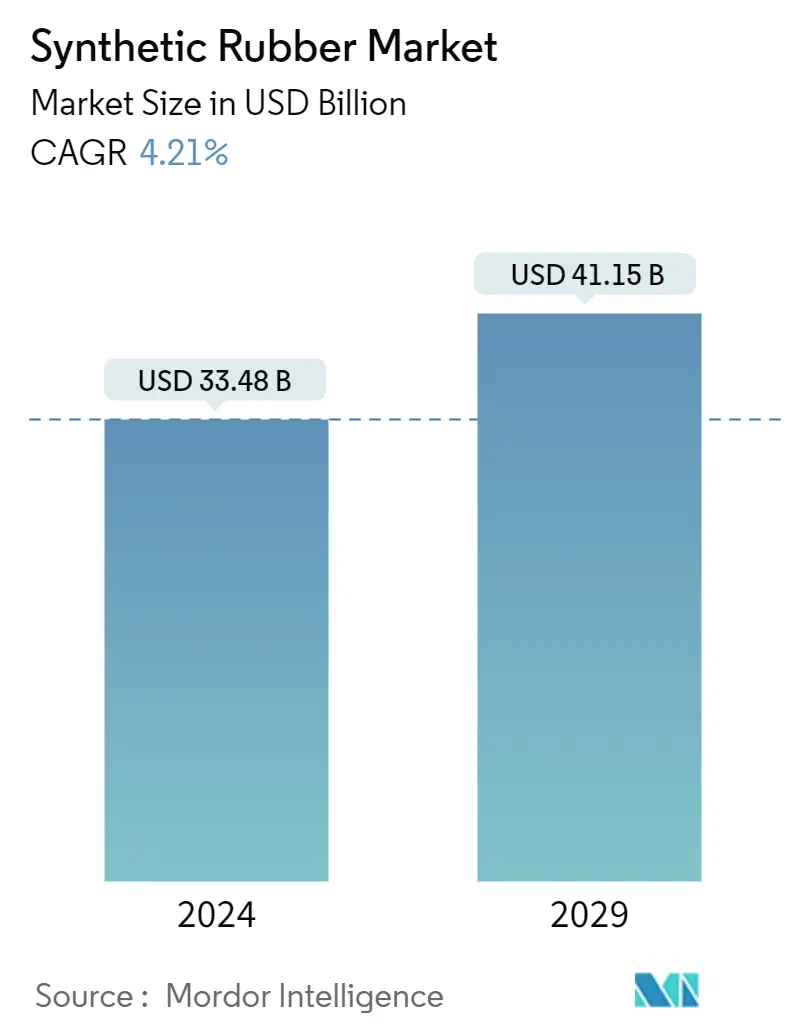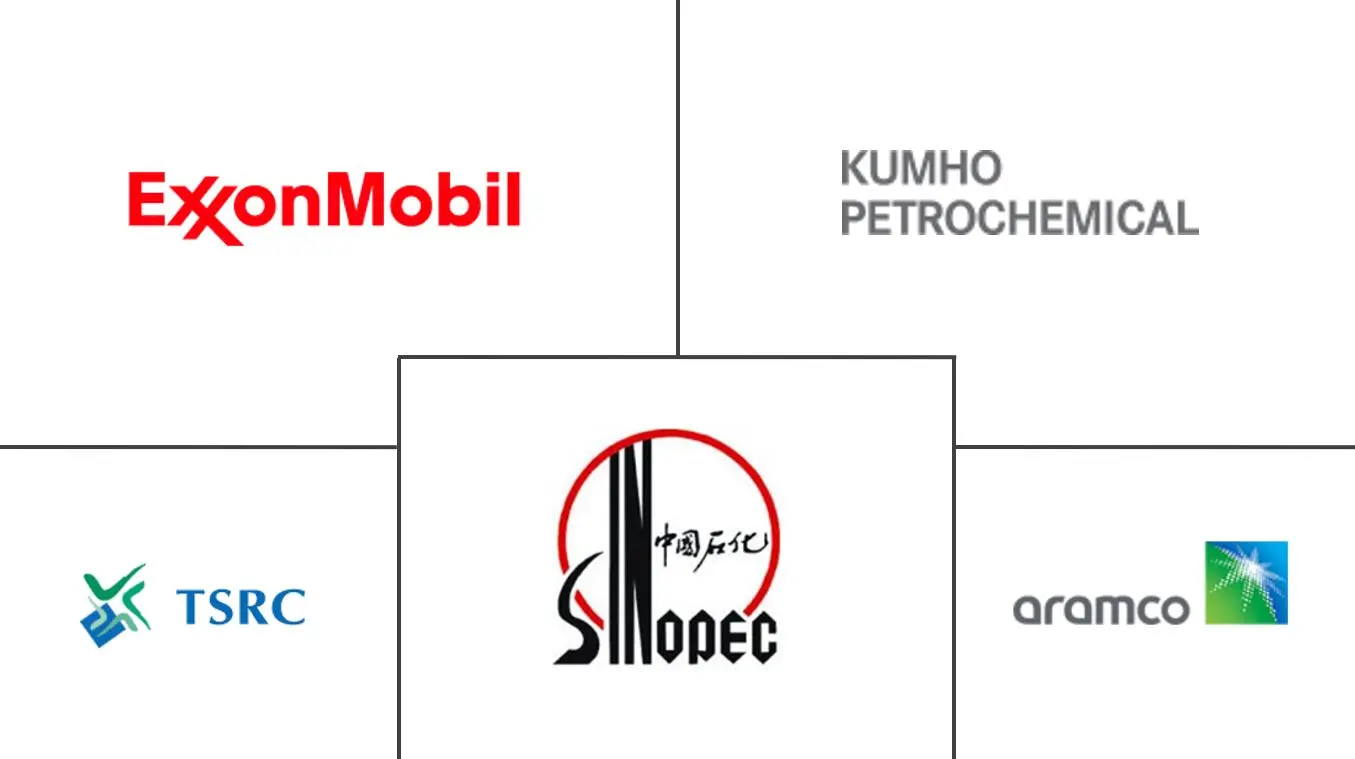Market Size of Synthetic Rubber Industry

| Study Period | 2024 - 2029 |
| Market Size (2024) | USD 33.48 Billion |
| Market Size (2029) | USD 41.15 Billion |
| CAGR (2024 - 2029) | 4.21 % |
| Fastest Growing Market | Asia-Pacific |
| Largest Market | Asia-Pacific |
| Market Concentration | Low |
Major Players
*Disclaimer: Major Players sorted in no particular order |
Synthetic Rubber Market Analysis
The Synthetic Rubber Market size is estimated at USD 33.48 billion in 2024, and is expected to reach USD 41.15 billion by 2029, growing at a CAGR of 4.21% during the forecast period (2024-2029).
In 2020, due to the COVID-19 pandemic, the global synthetic rubber market experienced a downturn, resulting in widespread lockdowns, disruptions in manufacturing and supply chains, and production stoppages. However, conditions began to improve in 2021-2022, and the market is expected to grow year-on-year during the forecast period as automotive demand is expected to increase.
- The growth of the market is expected to receive a boost due to the increasing production of electric vehicles.
- On the other hand, using polyurethanes instead of synthetic rubber in some applications is likely to decelerate the growth of the market.
- Future opportunities for the market could come from the development of bio-based feedstock for synthetic rubber and the growing demand for medical gloves.
- Due to high demand from China, India, and Japan, Asia-Pacific has the largest market share and is likely to lead the market during the forecast period.
Synthetic Rubber Industry Segmentation
Synthetic rubber is a man-made rubber produced by combining minerals and oil in plants. The most commonly used type of synthetic rubber is styrene-butadiene rubber (SBR), which is created by copolymerizing styrene and 1,3-butadiene.
The synthetic rubber market is segmented by type, application, and geography. By type, the market is segmented into styrene-butadiene rubber, ethylene propylene diene rubber, polyisoprene rubber, polybutadiene rubber, isobutylene isoprene rubber, and other types. By application, the market is segmented into tire and tire components, non-tire automobile applications, footwear, industrial goods, and other applications (consumer goods, etc.). The report also covers the market size and forecasts in 27 countries across major regions. For each segment, market sizing and forecasts were made based on revenue (USD).
| Type | |
| Styrene Butadiene Rubber (SBR) | |
| Ethylene Propylenediene Rubber (EPDM) | |
| Polyisoprene (IR) | |
| Polybutadiene Rubber (BR) | |
| Isobutylene Isoprene Rubber (IIR) | |
| Other Types |
| Application | |
| Tire and Tire Components | |
| Non-tire Automobile Applications | |
| Footwear | |
| Industrial Goods | |
| Other Applications |
| Geography | |||||||||||
| |||||||||||
| |||||||||||
| |||||||||||
| |||||||||||
|
Synthetic Rubber Market Size Summary
The synthetic rubber market is poised for steady growth over the forecast period, driven by increasing demand in the automotive sector, particularly with the rise in electric vehicle production. The market, which faced challenges during the COVID-19 pandemic due to disruptions in manufacturing and supply chains, has shown signs of recovery and is expected to expand as automotive demand rebounds. However, the market's growth may be tempered by the substitution of synthetic rubber with polyurethanes in certain applications. Opportunities for further expansion lie in the development of bio-based feedstock and the rising demand for medical gloves. The Asia-Pacific region, led by countries like China, India, and Japan, holds the largest market share, supported by robust demand and significant production capabilities in these nations.
The tire and tire components segment dominates the synthetic rubber market, with styrene-butadiene rubber being the material of choice due to its durability and wear resistance. This segment's growth is bolstered by the increasing production of passenger cars and the expansion of the tire industry, particularly in China and the United States. The fragmented nature of the market sees major players like Exxon Mobil Corporation, Kumho Petrochemical, and Saudi Arabian Oil Co. actively participating in capacity expansions and technological advancements. Recent developments, such as the upgrade of halobutyl rubber capacities and the establishment of new production plants, underscore the industry's commitment to meeting growing global demand. These factors collectively contribute to the anticipated growth trajectory of the synthetic rubber market during the forecast period.
Synthetic Rubber Market Size - Table of Contents
-
1. MARKET DYNAMICS
-
1.1 Drivers
-
1.1.1 Increasing Demand from Rising Sales of Electric Vehicles
-
1.1.2 Other Drivers
-
-
1.2 Restraints
-
1.2.1 Replacement of Rubber by Polyurethanes in Some Applications
-
1.2.2 Other Restraints
-
-
1.3 Industry Value Chain Analysis
-
1.4 Porter's Five Forces Analysis
-
1.4.1 Bargaining Power of Suppliers
-
1.4.2 Bargaining Power of Consumers
-
1.4.3 Threat of New Entrants
-
1.4.4 Threat of Substitute Products and Services
-
1.4.5 Degree of Competition
-
-
-
2. MARKET SEGMENTATION (Market Size in Value)
-
2.1 Type
-
2.1.1 Styrene Butadiene Rubber (SBR)
-
2.1.2 Ethylene Propylenediene Rubber (EPDM)
-
2.1.3 Polyisoprene (IR)
-
2.1.4 Polybutadiene Rubber (BR)
-
2.1.5 Isobutylene Isoprene Rubber (IIR)
-
2.1.6 Other Types
-
-
2.2 Application
-
2.2.1 Tire and Tire Components
-
2.2.2 Non-tire Automobile Applications
-
2.2.3 Footwear
-
2.2.4 Industrial Goods
-
2.2.5 Other Applications
-
-
2.3 Geography
-
2.3.1 Asia-Pacific
-
2.3.1.1 China
-
2.3.1.2 India
-
2.3.1.3 Japan
-
2.3.1.4 South Korea
-
2.3.1.5 Malaysia
-
2.3.1.6 Thailand
-
2.3.1.7 Vietnam
-
2.3.1.8 Indonesia
-
2.3.1.9 Rest of Asia-Pacific
-
-
2.3.2 North America
-
2.3.2.1 United States
-
2.3.2.2 Canada
-
2.3.2.3 Mexico
-
-
2.3.3 Europe
-
2.3.3.1 Germany
-
2.3.3.2 United Kingdom
-
2.3.3.3 France
-
2.3.3.4 Italy
-
2.3.3.5 Spain
-
2.3.3.6 Russia
-
2.3.3.7 NORDIC
-
2.3.3.8 Turkey
-
2.3.3.9 Rest of Europe
-
-
2.3.4 South America
-
2.3.4.1 Brazil
-
2.3.4.2 Argentina
-
2.3.4.3 Colombia
-
2.3.4.4 Rest of South America
-
-
2.3.5 Middle-East and Africa
-
2.3.5.1 Saudi Arabia
-
2.3.5.2 South Africa
-
2.3.5.3 United Arab Emirates
-
2.3.5.4 Nigeria
-
2.3.5.5 Qatar
-
2.3.5.6 Egypt
-
2.3.5.7 Rest of Middle-East and Africa
-
-
-
Synthetic Rubber Market Size FAQs
How big is the Synthetic Rubber Market?
The Synthetic Rubber Market size is expected to reach USD 33.48 billion in 2024 and grow at a CAGR of 4.21% to reach USD 41.15 billion by 2029.
What is the current Synthetic Rubber Market size?
In 2024, the Synthetic Rubber Market size is expected to reach USD 33.48 billion.

